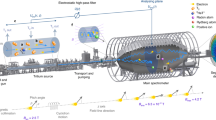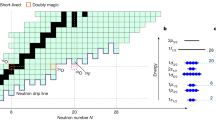Abstract
Determining whether neutrinos have mass is an important test of grand unified theories. Neutrino masses can in principle be measured from small distortions in the spectra of electrons emitted in low-energy β-decay processes. Detailed knowledge of the β-particles' spectral shape and the detector response is therefore required in order to distinguish1,2,3,4,5 real effects from instrumental artefacts. The interaction between the emitted β-particle and its local environment is predicted6 to produce oscillations in the β-particle spectrum, known as β environmental fine structure; the effect is analogous to extended X-ray absorption fine structure7 (EXAFS), which provides the basis for spectroscopic surface studies of local molecular structure. But the low energy resolution and high operating temperatures of traditional radiation detectors have precluded observation of β environmental fine structure. Cryogenic microcalorimeters, operated as particle detectors, offer a means of overcoming these problems, as they can reach energy resolutions up to ten times higher than traditional detectors8. Here we report the detection of β environmental fine structure in the β-decay spectrum of 187Re, using a cryogenic microcalorimeter. Our results, which are in good agreement with recent theoretical predictions9, may facilitate studies of molecular or crystalline structures in a manner similar to EXAFS.
This is a preview of subscription content, access via your institution
Access options
Subscribe to this journal
Receive 51 print issues and online access
$199.00 per year
only $3.90 per issue
Buy this article
- Purchase on Springer Link
- Instant access to full article PDF
Prices may be subject to local taxes which are calculated during checkout



Similar content being viewed by others
References
Simpson, J. J. Evidence of heavy neutrino emission in beta-decay. Phys. Rev. Lett. 54, 1891–1893 ( 1985).
Sur, B. et al. Evidence for the emission of a 17-keV neutrino in the β decay of 14C. Phys. Rev. Lett. 66, 2444–2447 (1991).
Datar, V. M., Baba, C. V. K., Bhattacherjee, S. K., Bhuinya, C. R. & Roy, A. Search for a heavy neutrino in β-decay of 35S. Nature 318, 547– 548 (1985).
Stoeffl, W. & Decman, D. J. Anomalous structure in the beta decay of gaseous molecular tritium. Phys. Rev. Lett. 75, 3237–3240 (1995).
Belesev, A. I. et al. Results of the Troitsk experiment on the search for the electron antineutrino rest mass in tritium beta decay. Phys. Lett. B 350, 263–272 (1995).
Koonin, S. E. Enironmental fine structure in low-energy β-particle spectra. Nature 354, 468–469 ( 1991).
Ashley, C. A. & Doniach, S. Theory of extended x-ray absorption edge fine structure (EXAFS) in crystalline solids. Phys. Rev. B 11, 1279–1288 ( 1975).
Booth, N., Cabrera, B. & Fiorini, E. Low temperature particle detectors. Annu. Rev. Nucl. Part. Sci. 46, 471–532 (1996).
Swift, A. M. The Study of the β Environmental Fine Structure Applied to the β-decay of 187 Re 1–16 (Preprint INFN/BE-97/02, INFN, Genoa, (1997)).
Lee, P. A., Citrin, P. H., Eisemberg, P. & Kincaid, B. M. Extended x-ray absorption fine structure—its strengths and limitations as a structural tool. Rev. Mod. Phys. 53, 769–806 (1981).
Lee, P. A. & Pendry, J. Theory of the extended x-ray absorption fine structure. Phys. Rev. B 11, 2795– 2811 (1975).
Eckerlin, P. & Kandler, H. Landolt Börnstein New Series 6, 21 (eds Hellwege, K. H. & Hellwege, A. M.) (Springer, Berlin, (1971)).
Stahle, C. K., Kelley, R. L., McCammon, D., Moseley, S. H. & Szymkowiak, A. E. Microcalorimeter array for high resolution soft x-ray spectroscopy. Nucl. Instrum. Methods Phys. Res. A 370, 173–176 (1996).
Galeazzi, M. Status of the rhenium beta experiment for neutrino mass study. Nucl. Phys. B (Proc. Suppl.) 66, 203– 206 (1998).
Fontanelli, F., Galeazzi, M., Gatti, F., Swift, A. M. & Vitale, S. Nucl. Instrum. Methods Phys. Res. A (submitted).
Caso, C. et al. Review of particle physics. Eur. Phys. J. C 3, 1–784 (1998).
Acknowledgements
This work was supported by INFN and the EC-HCM Programme ‘Cryogenic Detectors’.
Author information
Authors and Affiliations
Corresponding author
Rights and permissions
About this article
Cite this article
Gatti, F., Fontanelli, F., Galeazzi, M. et al. Detection of environmental fine structure in the low-energy β-decay spectrum of 187Re. Nature 397, 137–139 (1999). https://doi.org/10.1038/16414
Received:
Accepted:
Issue Date:
DOI: https://doi.org/10.1038/16414
This article is cited by
-
The calorimetric spectrum of the electron-capture decay of 163Ho. The spectral endpoint region
Journal of High Energy Physics (2016)
-
Direct neutrino mass measurements
Hyperfine Interactions (2013)
-
The MARE Project
Journal of Low Temperature Physics (2008)
-
A new twist in β-decay
Nature (1999)
Comments
By submitting a comment you agree to abide by our Terms and Community Guidelines. If you find something abusive or that does not comply with our terms or guidelines please flag it as inappropriate.



